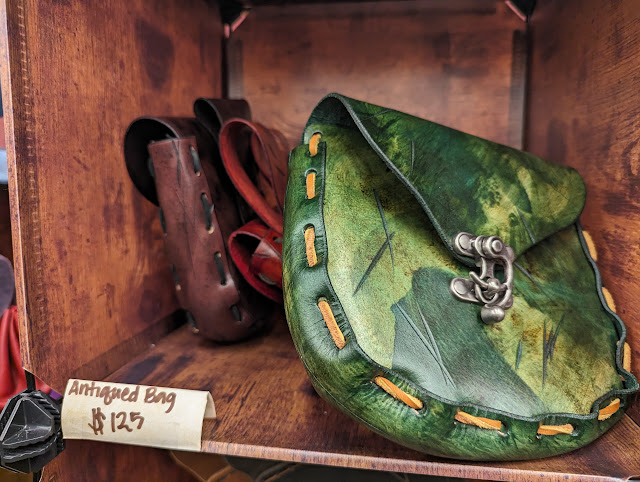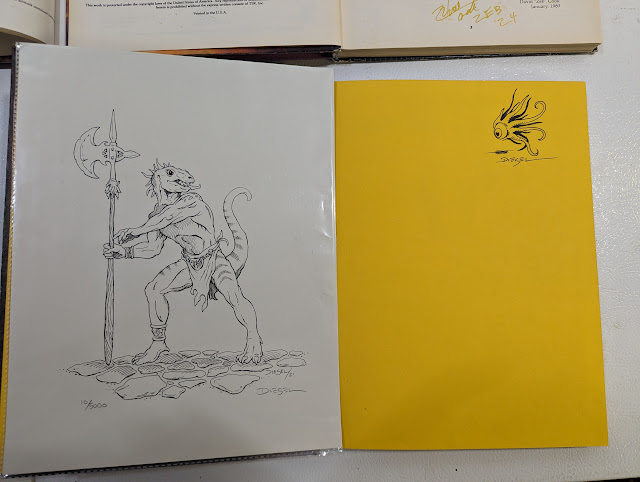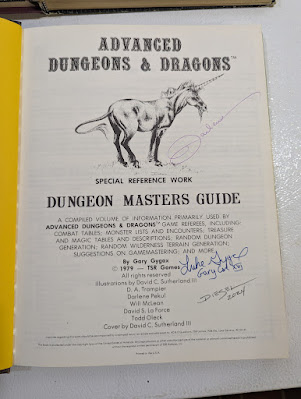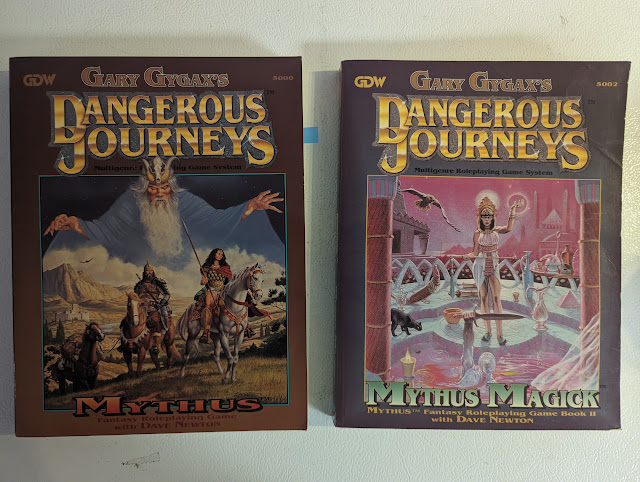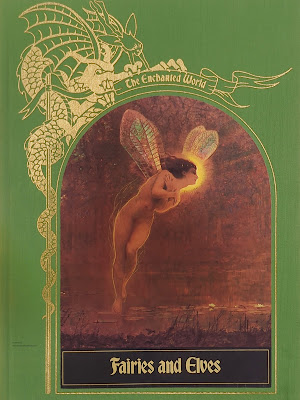Let's go forward a few years and see what lessons, if any, we have learned from Dangerous Journeys and Mythus.
So 1999 was an interesting year. I had been away from D&D for a while (nearly four years) and had been playing other games. I picked Chill back up but had not played it much, played a lot of WitchCraft RPG and dabbled a bit in Mage. Meanwhile, AD&D 2nd Ed was winding down, and 3rd Edition, the first from Wizards of the Coast, was on the way.
This was the environment in which Gary Gygax chose to release his Lejendary Adventure.
Lejendary Adventure - Core Rules (1999)
Gary Gygax. 208 pages. Color covers. Black & white interior art.
Published by Hekaforge Productions (originally). Troll Lord Games would later pick up this game and publish new material for it.
This game is hard to quantify. I can't tell if it feels old because this is 2024, 25 years after it was released, or if it would have felt old in 1999. It is wonderfully complicated (though less so than D&D) in the over-wrought way of many games of the late 80s, though I will say there seems to be less "High Gygaxian" here. Though there are plenty of odd spellings. I'm unsure if they are here to be different or to keep the lawyers from snooping around too much. "No, your honor, these are Ilfs and Wylfs, not Elfs." There are a lot of terms to digest for characters, and it makes for an unnecessary uphill climb. This is a game for gamers.
This is a fantasy RPG and just a few steps removed from a Fantasy Heartbreaker, to be honest. If it had been designed by anyone other than Gary Gygax, it would be an interesting curiosity. Though there is a robust character creation system here. Gary wanted to go beyond classes and allow players to play what they wanted. Many games have already done this, so this feels a little like trying to catch up. I still applaud the efforts and the results.
We get the basics. What is a Role-playing game? What are the players' roles, and what is the role of the Lejend Master? Yes, that is what the GM is called and how it is spelled. It is interesting to see Gary's lament of winning interest in RPGs by younger players. People who had not even been born yet when he wrote this are now playing the fifth edition of his first game in numbers that would have been staggering to him in 1974. It's too bad he did not get to see this.
We do get a Glossary in the beginning. It is full of terms like AB Activity Block, ABC Activity Block Count, AEP: Activation Energy Potential...and I am already forgetting what I just read five entries ago.
The Avatar
The Avatar is your character in the game. It was a term that felt odd then, but now I think most people can grasp it quickly enough. This leads some weight to the rumor that this was developed as the basis for a video game RPG, not a tabletop one. But I am not sure.
Anyway, your Avatar can be one of the following Species (yes, Gary does say Species, but he also says Races): Dwarves, Ilves, Wylves (Elves both), Oaf, Orc, Trollkin, Gnomes, Kobolds, and Veshoge.
The core mechanic is a d100-based one. Character abilities are represented by Base Ratings in Health, Precision, and Speed, with an optional rule for Intellect. The Base Ratings have 100 points to distribute among them, keeping in mind the minimum and maximum for each race. Then you can roll to get a bit of randomness. This can result in base ratings ending in .5 in some cases (most often Speed) and later on some other awkward numbers. I am already getting Mythus flashbacks.
Abilities are numerous and cover things Alchemia, Arcana, and so on. Think of these as skills in other games. Each of these 38 Abilities are tied to the Base Rating. So Sorcery for example is part of Speed. I get the distinct feeling that Gary wanted something akin to the "Mental," "Physical," and "Spiritual" he had used in Dangerous Journeys, but those were being used now in BESM and Tri-Stat (the Tri stats, Mind-Body-Spirit). Again, abilities are largely determined by race. Which is an unfortunate hold-over of an age now gone. So yeah, not a fan really.
There is a good section on page 13 that helps define your character I mean Avatar. It would be useful in other games too. There are three examples of helpful character creation.
The Race descriptions are next. While there are some similar names here, don't go in respecting them to be the same. For example, the Kobold are more like thin halflings. Oafs are ogres, and trollkins...well if you can picture the Trolls from the various Trolls animated movies, the ones where they sing not eat Christians, then you have a better idea.
Orders and Benefits
These are like classes, but not 100% really. I mean they used to tell one magic using type from another, but I guess a better description is an occupation.
Avatar Abilities (details)
This details the various skills, aka "Abilities," the Avatar has and the effects they have. These abilities can change what Orders you could belong to. Also, while the Base Ratings affect the Abilities, the Abilities also raise the Base Ratings. I guess the logic here is like exercise; you can get more skillful at something AND build the muscles you used to do it at that same time. The logic is not unsound but has some interesting (and annoying) side effects. Namely, as you advance your abilities, your base ratings change. I have created one character, and I am already seeing Base Ratings change a lot (and I am also getting numbers like 14.6 and 58.4), so I am prepared to use that eraser.
Equipment Lists
Gary always loved his Equipment lists. So here they are.
Enchantments, Geourgy, Necrourgy, Psychogenic, Sorcery, & Theurgy
The magic and "spells" of the various Orders. Each one gets its own chapter-sized section. This covers about 110 pages.
The Journey
These are the rules for play. Interestingly enough, this is a small section that covers the basics and most of the situations the Avatars will run into. I think the bulk must be in the Lejend Master's book.
Making a Character
Ok, I made a character. To be honest, I am not 100% sure I did everything right, so I am waiting until I read through Lejend Master's book.
The Lejendary Earth / Mythus Ærth Connections
Like Dangerous Journeys, Lejendary Adventure was thought to exist on a parallel Earth, sometimes called Learth. Compare that to Dangerous Journeys Mythus' "Ærth" and D&D's "Oerth" and "Urt" or "Uerth" from the Frank Mentzer-penned D&D Immortals. I guess we are just missing an "Ierth."
It feels like there are some solid similarities in the campaign worlds of these two games. No surprise since Dangerous Journeys was cut down long before it could become big enough to support a detailed campaign world. In some ways, I like to think of all these worlds, Ærth, Oerth, Learth, and Urt, as having connections to each other.
There is not enough here to make me think that Lejendary Adventure is in any way a redo of Dangeous Journeys. In truth after going over this, and then Mythus, and then back to this I am struck by how some of the material in LA that I considered to be "High Gygaxian" doesn't measure up to the text in DJ:M.
One of the companies that gave us Lejendary Adventure is named Hekaforge (cover has Hekaforge, the interiors have Trigee), so I think Gary was really invested in the ideas of Dangerous Journeys, but maybe not all the applications.
So LA reads better than DJ:M, but it also lacks some of the charm. Neither game is going to replace AD&D on my table.
I am 100% certain there is a group out there that has, in the past, tried to reconcile Dangerous Journeys, Lejendary Adventure, and AD&D. The desire is there for me to try, but it is not strong enough to actually do it. Maybe I'll make avatars for all these Gygazian Earths (Oerth, Uerth, Ærth, and Learth) and how they come together somehow. In truth, I should make a unique Witch Queen for each. Given there are four worlds, maybe each is also attached to an element? I think I'll search online and see if others have done much with these games and see what I can glean from that. After all, if YOU put in the work into these games to actually run a campaign or two, then that deserves to be memorialized.
Up next, the Lejend Master's book and then some monsters.










